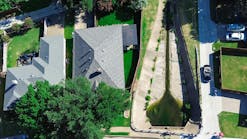USC researchers develop models to track aquifer contaminants
As new pressures, such as climate change, deepen, the accuracy and reliability of risk analysis models regarding basic issues, like the cleanliness of our water, have become more important than ever.
USC researchers, including Felipe de Barros, associate professor of civil and environmental engineering in the USC Viterbi School of Engineering, have developed a variety of models that can help assess how emerging contaminants disperse, dissolve and ultimately impact water quality and the resilience of aquifers.
"The subsurface environment is very complex and challenging to track, because we cannot see it," de Barros said. "We don't have detailed information on how deep the contaminants are, how far out they are spread, where they are coming from, what other contaminants they have mixed with or how the geological properties vary in space."
These questions are exactly what de Barros and his team work on. Recently, de Barros and collaborators developed an analytical model that can help predict contaminant spreading in fractured porous media under different water flow scenarios. This work was featured in Physics Review Fluids. The advantage of the analytical model developed by de Barros and collaborators is that it allows to look at the relationships between varying geological and physical parameters to see how they impact dissolution of a contaminant as water flows from one point to another.
"It's like studying alternative realities--like in a comic book universe," de Barros said. "If you can understand what happens with each different scenario, you can better predict outcomes in real time and better allocate resources to mitigate the problem."
"With tools like this one, you can do probabilistic risk analysis and compute and assess the risks associated with a waste disposal facility, for example, or with an accidental leak," he said. "We can also understand how fast these chemicals are going to travel in these environments."
For example, if there were a chemical spill near an aquifer: With accurate risk modeling that accounts for key heterogeneous variables in the environment, health professionals and regulatory bodies could better understand how much of a contaminant they can expect to be in the end water source, de Barros said.
"This modeling can help with questions like, 'Should I invest more money in public health or in characterizing the geological site? Should I shut down the well--which is very costly--or bring in tap water from another location or buy bottled water, or is there reasonable knowledge that the water can still be used, once treated?" he said.
Felipe de Barros and his team looked at the complex physics of water flow through different flow systems, namely where restricted flow, like through a porous membrane, meets free flow, like the space between two porous surfaces. How these areas interact are important in determining how a chemical dissolves or mixes in a water source, he said.
Instead of solving the physical equations numerically to model different outcomes, the team looked tackled the problem by developing analytical solutions that are computationally cheap. Identifying relationships between elements of the model allowed them to "upscale" it, simplifying the math involved by distilling these trends into fewer terms then embedded into their equation.
To create a model that encapsulated these key parameters and behaviors, the researchers looked at the geometric features of the subsurface structures. Porosity and permeability of the subsurface environment or aspect ratio characterizing the fractures were key elements that were considered, de Barros said.
As surface water becomes increasingly scarce, subsurface sources and treatment options will need to be tapped into increasingly. At the same time, however, with pollution and chemical contaminants leaking into water sources, the challenge is identifying how to gauge safety of a certain flow without fully understanding the invisible unknowns impacting it.
One thing our research aims to go, de Barros said, is to develop application-oriented models that improve our fundamental understanding on the interaction between the geological media and solute transport behavior. This would allow to see how contaminant dispersion is influenced by shifting conditions. For example, how does a contaminant leak through to the other side of a cracked rock versus one that has no fissures? Because so many potential contaminants can be found in the water, this helps create a general understanding of the subsurface system without relying on knowing the exact contaminants in question.
This knowledge can also allow for reverse engineering, for example building a system to have certain hydrogeological conditions that could be help achieve a desired chemical concentration or water quality output.
"Understanding how the concentration of a chemical changes in a given system through space and time can have implications for public health, water treatment operations and also regulatory policies, for instance as issued by the U.S. EPA," de Barros said.
SOURCE: University of Southern California, via EurekAlert
B. Ling, C. B. Rizzo, I. Battiato, F. P. J. de Barros. Macroscale transport in channel-matrix systems via integral transforms. Physical Review Fluids, 2021; 6 (4) DOI: 10.1103/PhysRevFluids.6.044501






